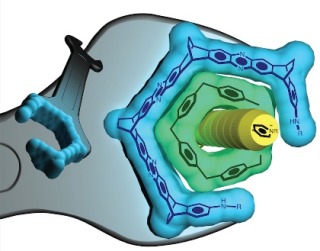Severin Schneebeli, a chemist from the University of Vermont, has discovered a new way to use chirality – an asymmetric property in identical structures – to make a nanoscale wrench.
 A blue wrench (of molecules) to adjust a green bolt (a pillarene ring) that binds a yellow chemical “guest.” It’s a new tool — just 1.7 nanometers wide — that could help scientists catalyze and create a host of useful new materials. (Image courtesy of Severin Schneebeli)
A blue wrench (of molecules) to adjust a green bolt (a pillarene ring) that binds a yellow chemical “guest.” It’s a new tool — just 1.7 nanometers wide — that could help scientists catalyze and create a host of useful new materials. (Image courtesy of Severin Schneebeli)
Chirality is a word that originates from the Greek language, with a chiral molecule having two identical but opposite forms. Chirality can be seeen in human hands, which are identical but mirror opposites. It is impossible to superimpose them onto one another.
This discovery enables precise control of nanoscale shapes, and is a potential method for fast and accurate creation of customized molecules. The concept of “chirality-assisted synthesis” is a new approach to controlling the shape of large molecules, which is a basic step in the generation of new complex synthetic materials, such as medicines and polymers.
The research results were published online in the chemistry journal 'Angewandte Chemie'.
Like Legos
Schneebeli and his team conducted the experiment using anthracene, a substance found in coal. In this experiment, C-shaped strips of molecules were assembled that were able to attach to each other in a single direction only due to their chirality.
“They’re like Legos,” Schneebeli explains. These molecular strips create a rigid structure that can hold rings of other chemicals “in a manner similar to how a five-sided bolt head fits into a pentagonal wrench,” the team writes.
These C-shaped strips attach to one another through two bonds in a single geometric orientation. Therefore, unlike numerous chemical structures that have the same general formula and are flexible enough to twist and rotate into various shapes, these C-shaped strips of molecules had only one shape. “This has only one shape,” Schneebeli says. “It's like a real wrench,” he says. The opening in this shape was a hundred-thousand times thinner than the width of human hair at approximately 1.7 nm.
“It completely keeps its shape,” he explains, even at varied temperatures and different solvents, “which makes it pre-organized to bind to other molecules in one specific way."
The results of the study demonstrate that the wrench can strongly bind to a group of large molecules well-known as “pillarene macrocycles.” These pillarene rings have been used as “hosts” for surrounding and modifying other “guest” chemicals in between them. These rings are used in numerous applications, from organic light-emitting substances to drug delivery.
“By embracing pillarenes,” the UVM team writes, “the C-shaped strips are able to regulate the interactions of pillarene hosts with conventional guests.”
The new wrench can be used to remotely control the chemical environment within the pillarene, just as a mechanic adjusts the performance of an engine by turning an external bolt.
The new wrench can make binding to the inside of the pillarene rings "about one hundred times stronger” than it would be without the wrench, Schneebeli says.
Making Models
"Because this kind of molecule is rigid, we can model it in the computer and project how it looks before we synthesize it in the lab,” says UVM theoretical chemist Jianing Li, Schneebeli’s collaborator on the research and a co-author of the study.
Li created comprehensive simulations on the function of the new wrench with the help of computer processors at the Vermont Advanced Computing Core.
“This is a revolutionary idea,” Li said. “We have 100 percent control of the shape, which gives great atomic economy — and lets us know what will happen before we start synthesizing in the lab.”
Xiaoxi Liu, post-doctoral researcher and lead author, Zackariah Weinert, ’16 undergraduate student, and other team members considered computer simulations as a guide for testing the actual chemistry in the lab. An NMR Spectrometer and a mass spectrometer available in the chemistry department of UVM were used to corroborate Schneebeli’s findings.
Creative Simplicity
Sir Fraser Stoddart, a world-leading chemist at Northwestern University, described the new study as, “Brilliant and elegant! Creative and simple.” And, indeed, it’s the simplicity of the approach that makes it powerful, Schneebeli says. “It’s all based on geometry that controls the symmetry of the molecules. This is the only shape it can take — which makes it very useful.”
The team plans to alter the C-shaped pieces that are bound by two bonds between two bromines and nitogens to generate new shapes.
“We’re making a special kind of spiral which is going to be flexible like a real spring,” Schneebeli explains, but will hold its shape even under great stress.
“This helical shape could be super-strong and flexible. It could create new materials, perhaps for safer helmets or materials for space,” Schneebeli says. “In the big picture, this work points us toward synthetic materials with properties that, today, no material has."